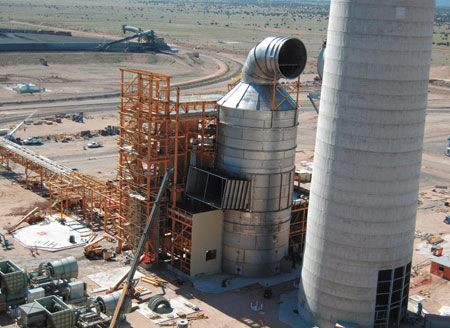A massive construction project is underway at Coronado Generating
Station to meet the terms of a 2008 settlement with the EPA.
The Salt River Project is spending approximately $550 million
to fit the facility's power generating units with two new scrubbers
and new burners.
The burners are designed to lower the output of nitric-oxide
and the new scrubbers will reduce the facilities output of
sulfur-dioxide. The company has also agreed to install a selective
catalytic reduction system (SRCS) to further lower its nitric oxide
emmissions.
Sulfur dioxide emmissions have been implicated in the
production of acid rain. Nitric oxide presents various health risks
in addition to a visible haze. The planned SRCS will act similarly
to the catalytic converter on an automobile - both are designed to
reduce nitric oxide. The SRCS, however, will use ammonia to do its
chemical work. (Don't confuse nitric oxide with the gas that helps
make dental work tolerable - nitrous oxide.)
With the current retrofit, Coronado should be able to continue
generating electricity for SRP's Valley customers for another 20
years.
Construction on the two-unit power plant was started on July
25, 1974. The first unit was completed Dec. 31, 1979 and the second
unit was completed Oct. 1, 1980. The two units are capable of
generating 773 megawatts of electricity - enough power for 200,000
homes. The plant sends its electrical output on lines to the Valley
through Globe. Household voltage is 110, SRP sends its power at
500,000 volts. The higher voltage is more efficient for long
distance transmission, explained Tim Hunt, who's worked at Coronado
for 33 years.
SRP expects to have 250 construction workers on site this
summer. That number is expected to rise to 500 at the peak of
construction next spring.
The work so far is "on schedule and on budget," said project
manager William McClary.
SRP is working under tight deadlines.
The two new burners must be installed by June 2011, One of the
units is already online with the new nitric-oxide lowering burners.
The deadline for the first of two new scrubbers to be up and running
is Jan. 1, 2012.
These scrubbers - now being called absorbers - are not little
brushes. To scrub the output of coal burners 97 percent clean of
sulfur-dioxide requires new 400-foot tall stacks and a massive
building filled with equipment, and pumps and fans the size of a
ranch style house.
The retrofit is an international effort. For example, the two
giant fans - heavy duty variable pitch axial flow fans - for the
first scrubber are manufactured in Indonesia by Howden of Denmark.
The project is huge and it's made even more complex by having
to keep the facility producing power while construction goes on.
SRP's 200 workers have to keep the flames burning while 500 or so
construction workers stay on their deadlines.
Every week, four coal trains rumble down the 43 mile rail spur
to the plant. Each of these trains is dragging 102 cars, each loaded
with 100 tons. Every week 40,800 tons of coal from the Powder River
Basin of Wyoming is delivered. Three different types of coal are
used, mixed to provide the optimum blend.
The company is adding to its already active water recycling
programs with the new scrubbers but water usage is still in the
millions of gallons per year. The facility now has 17, 20-inch
wells.
With the implementation of the selective catalytic reduction
system the company will be introducing ammonia to the electrical
generation process. The ammonia is a boon for the environment but
workers will have to wear more protective clothing. The company will
also be using limestone, mined locally, in the scrubber process. The
result will be almost no sulfur-dioxide emissions, replaced by an
output of much more inert gypsum, the primary component in drywall.
Work underway on $550 million upgrade at Coronado
Generating Station
 |
Terence Corrigan - The Independent One of two new scrubbers is in place at Unit 2 of the SRP power plant northeast of St. Johns. |
*Reach the reporter at tcorrigan@wmicentral.com
Copyright © 2010 WMICentral.com - The White Mountain Independent's Online Edition To subscribe or visit go to: http://www.wmicentral.com